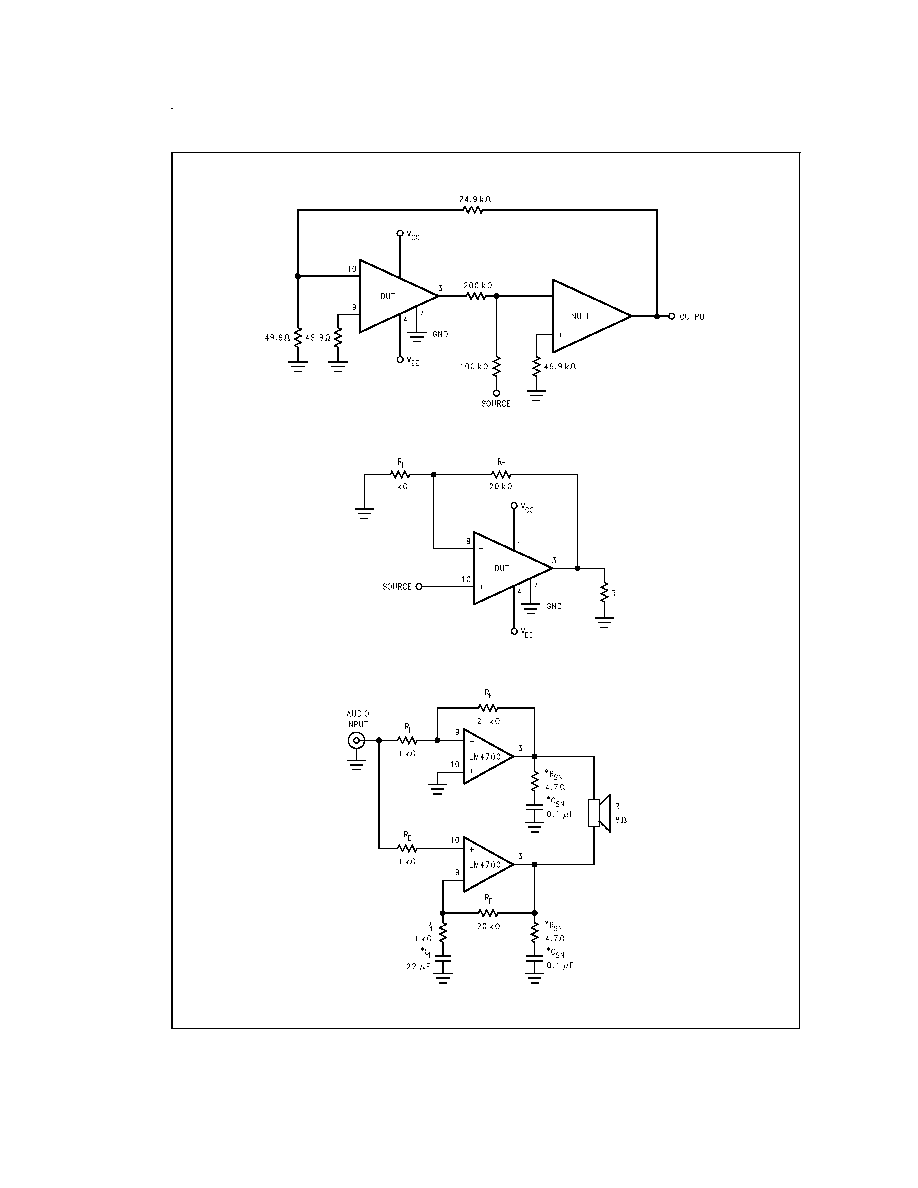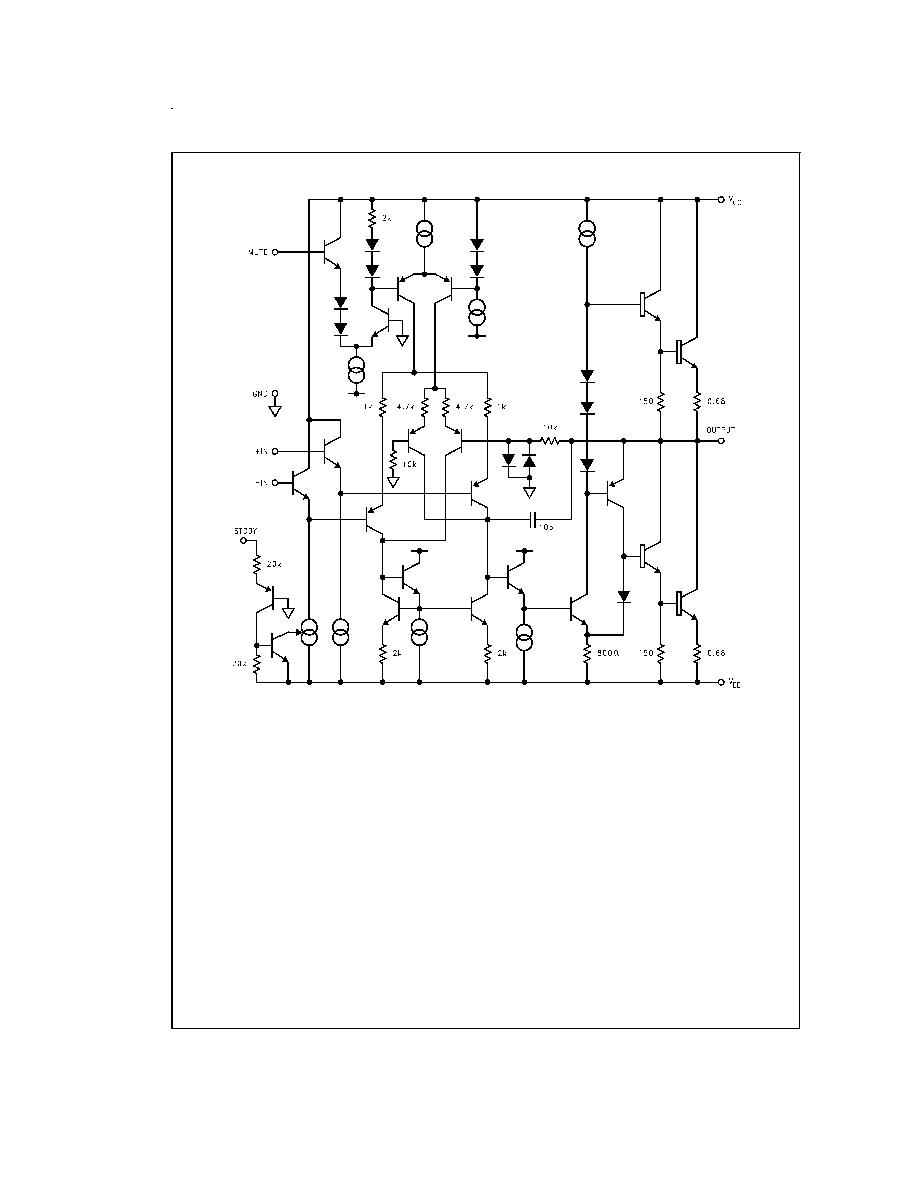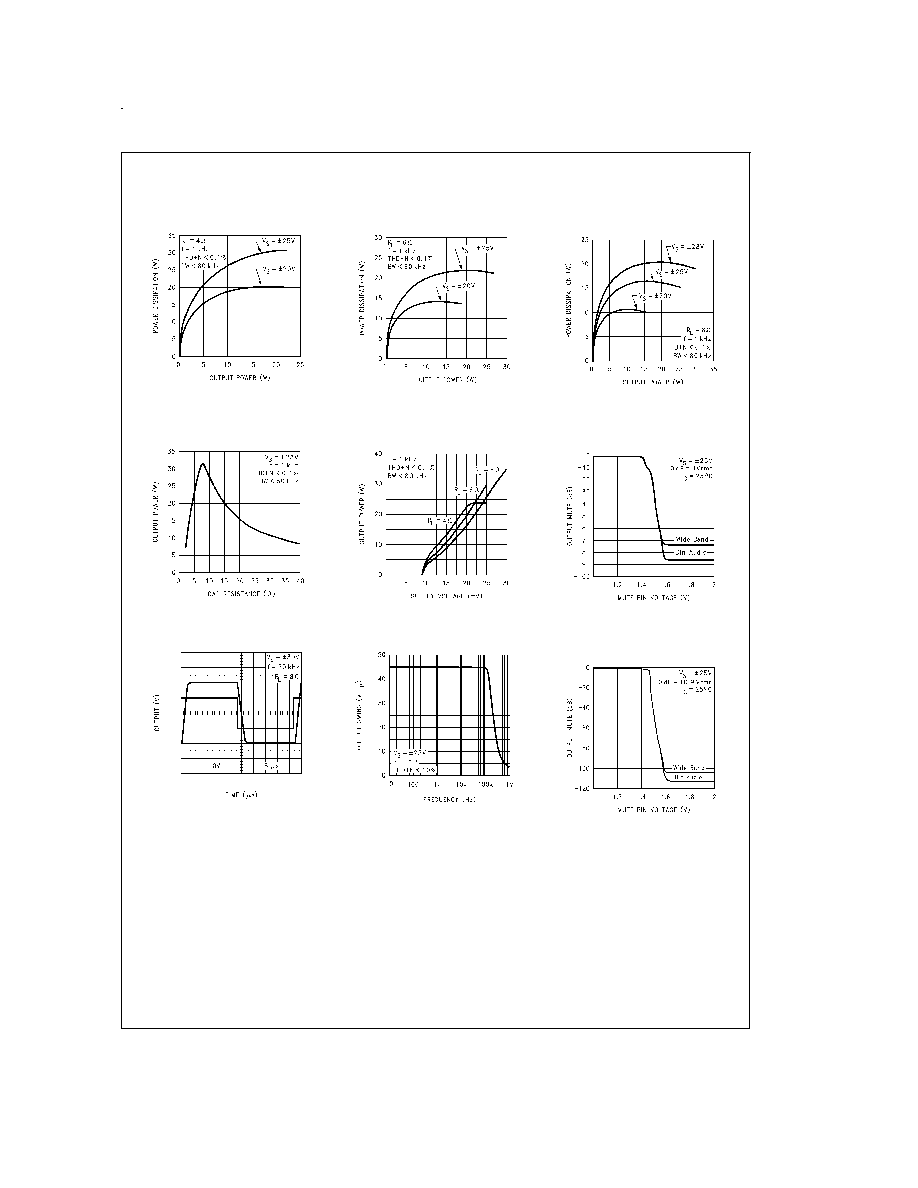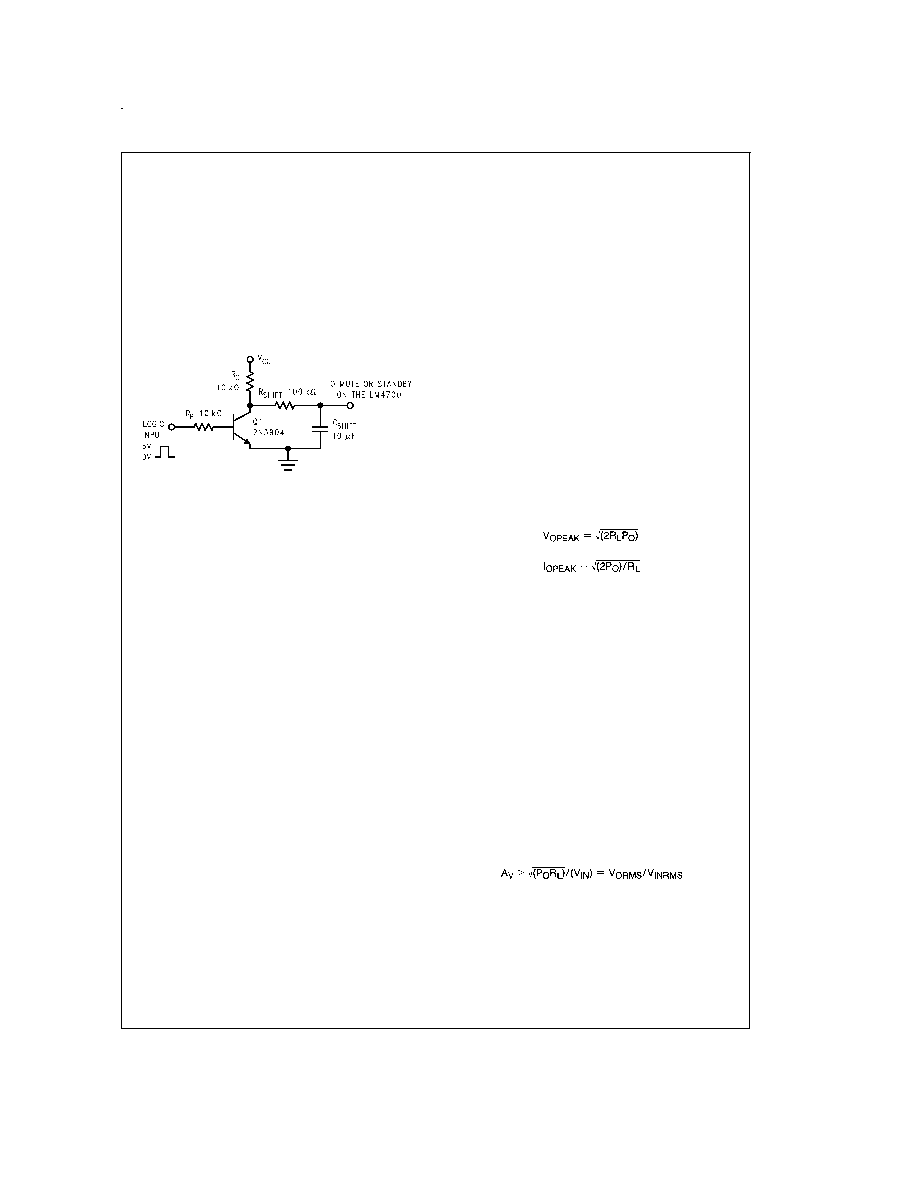 | –≠–ª–µ–∫—Ç—Ä–æ–Ω–Ω—ã–π –∫–æ–º–ø–æ–Ω–µ–Ω—Ç: LM4700 | –°–∫–∞—á–∞—Ç—å:  PDF PDF  ZIP ZIP |

LM4700
Overture
TM
Audio Power Amplifier Series
30W Audio Power Amplifier with
Mute and Standby Modes
General Description
The LM4700 is an audio power amplifier capable of deliver-
ing typically 30W of continuous average output power into an
8
load with less than 0.1% (THD + N).
The LM4700 has an independent smooth transition fade-in/
out mute and a power conserving standby mode which can
be controlled by external logic.
The performance of the LM4700, utilizing its Self Peak In-
stantaneous Temperature (∞Ke) (SPiKe
TM
) Protection Cir-
cuitry, places it in a class above discrete and hybrid amplifi-
ers by providing an inherently, dynamically protected Safe
Operating Area (SOA). SPiKe Protection means that these
parts are completely safeguarded at the output against over-
voltage, undervoltage, overloads, including thermal runaway
and instantaneous temperature peaks.
Key Specifications
n
THD+N at 1 kHz at continuous average output power of
25W into 8
:
0.1% (max)
n
THD+N from 20 Hz to 20 kHz at 30W of continuous
average output power into 8
:
0.08% (typ)
n
Standby current:
2.1 mA (typ)
Features
n
SPiKe Protection
n
Minimal amount of external components necessary
n
Quiet fade-in/out mute function
n
Power conserving standby-mode
n
Isolated 11-lead TO-220 package
Applications
n
Component stereo
n
Compact stereo
Typical Application
Connection Diagram
SPiKe
TM
Protection and Overture
TM
are trademarks of National Semiconductor Corporation.
DS012369-1
*
Optional components dependent upon specific design requirements. Refer
to the External Components Description section for a component functional
description.
FIGURE 1. Typical Audio Amplifier Application Circuit
Isolated Plastic Package
DS012369-2
Top View
Order Number LM4700TF
See NS Package Number TF11B
March 1998
LM4700
Overture
Audio
Power
Amplifier
Series
30W
Audio
Power
Amplifier
with
Mute
and
Standby
Modes
© 1999 National Semiconductor Corporation
DS012369
www.national.com

Absolute Maximum Ratings
(Notes 4, 5)
If Military/Aerospace specified devices are required,
please contact the National Semiconductor Sales Office/
Distributors for availability and specifications.
Supply Voltage |V
CC
| + |V
EE
|
(No Signal)
66V
Supply Voltage |V
CC
| + |V
EE
|
(with Input and Load)
64V
Common Mode Input Voltage
(V
CC
or V
EE
) and
|V
CC
| + |V
EE
|
60V
Differential Input Voltage
60V
Output Current
Internally Limited
Power Dissipation (Note 6)
62.5W
ESD Susceptibility (Note 7)
2000V
Junction Temperature (Note 8)
150∞C
Thermal Resistance
JC
(Note 14)
2∞C/W
JA
43∞C/W
Soldering Information
TF Package (10 sec.)
260∞C
Storage Temperature
-40∞C
T
A
+150∞C
Operating Ratings
(Notes 4, 5)
Temperature Range
T
MIN
T
A
T
MAX
-20∞C
T
A
+85∞C
Supply Voltage |V
CC
| + |V
EE
| (Note 1)
20V to 64V
Electrical Characteristics
(Notes 4, 5) The following specifications are for V
CC
= +28V, V
EE
= -28V with R
L
= 8
, unless otherwise specified. Limits ap-
ply for T
A
= 25∞C.
Symbol
Parameter
Conditions
LM4700
Units
(Limits)
Typical
Limit
(Note 9)
(Note
10)
|V
CC
| + |V
EE
|
Power Supply Voltage
GND - V
EE
9V
18
20
V (min)
(Note 11)
64
V (max)
P
O
Output Power
THD + N = 0.1% (max), f = 1 kHz
(Note 3)
(Continuous Average)
R
L
= 8
, |V
CC
| = |V
EE
| = 28V
30
25
W/ch
(min)
R
L
= 4
, |V
CC
| = |V
EE
| = 20V (Note 13)
22
15
W/ch
(min)
THD + N
Total Harmonic Distortion
30W/ch, R
L
= 8
,
0.08
%
Plus Noise
20 Hz
f
20 kHz, A
V
= 26 dB
SR (Note 3)
Slew Rate
V
IN
= 1.414 Vrms, t
rise
= 2 ns
18
12
V/µs (min)
I
TOTAL
Total Quiescent Power
V
CM
= 0V, V
O
= 0V, I
O
= 0 mA
(Note 2)
Supply Current
Standby: Off
25
40
mA (max)
Standby: On
2.1
mA
Standby Pin
V
IL
Standby Low Input Voltage
Not in Standby Mode
0.8
V (max)
V
IH
Standby High Input Voltage
In Standby Mode
2.0
2.5
V (min)
Mute Pin
V
IL
Mute Low Input Voltage
Output Not Muted
0.8
V (max)
V
IH
Mute High Input Voltage
Output Muted
2.0
2.5
V (min)
A
M
Mute Attenuation
V
PIN8
= 2.5V
115
80
dB (min)
V
OS
(Note 2)
Input Offset Voltage
V
CM
= 0V, I
O
= 0 mA
2.0
15
mV (max)
I
B
Input Bias Current
V
CM
= 0V, I
O
= 0 mA
0.2
0.5
µA (max)
I
OS
Input Offset Current
V
CM
= 0V, I
O
= 0 mA
0.002
0.2
µA (max)
I
O
Output Current Limit
|V
CC
| = |V
EE
| = 10V, t
ON
= 10 ms,
3.5
2.9
A
PK
(min)
V
O
= 0V
V
OD
Output Dropout Voltage
|V
CC
- V
O
|, V
CC
= 20V, I
O
= +100 mA
1.8
2.3
V (max)
(Note 2)
(Note 12)
|V
O
- V
EE
|, V
EE
= -20V, I
O
= -100 mA
2.5
3.2
V (max)
PSRR
Power Supply Rejection Ratio
V
CC
= 30V to 10V, V
EE
= -30V,
115
85
dB (min)
(Note 2)
V
CM
= 0V, I
O
= 0 mA
V
CC
= 30V, V
EE
= -30V to -10V
110
85
dB (min)
V
CM
= 0V, I
O
= 0 mA
www.national.com
2

Electrical Characteristics
(Continued)
(Notes 4, 5) The following specifications are for V
CC
= +28V, V
EE
= -28V with R
L
= 8
, unless otherwise specified. Limits ap-
ply for T
A
= 25∞C.
Symbol
Parameter
Conditions
LM4700
Units
(Limits)
Typical
Limit
(Note 9)
(Note
10)
CMRR
Common Mode Rejection Ratio
V
CC
= 35V to 10V, V
EE
= -10V to -35V,
110
80
dB (min)
(Note 2)
V
CM
= 10V to -10V, I
O
= 0 mA
A
VOL
(Note 2)
Open Loop Voltage Gain
R
L
= 2 k
,
V
O
= 30V
110
90
dB (min)
GBWP
Gain-Bandwidth Product
f
O
= 100 kHz, V
IN
= 50 mVrms
7.5
5
MHz (min)
e
IN
Input Noise
IHF -- A Weighting Filter
2.0
8
µV (max)
(Note 3)
R
IN
= 600
(Input Referred)
SNR
Signal-to-Noise Ratio
P
O
= 1W, A-Weighted,
98
dB
Measured at 1 kHz, R
S
= 25
P
O
= 25W, A-Weighted
108
dB
Measured at 1 kHz, R
S
= 25
Note 1: Operation is guaranteed up to 64V, however, distortion may be introduced from SPiKe Protection Circuitry if proper thermal considerations are not taken into
account. Refer to the Application Information section for a complete explanation.
Note 2: DC Electrical Test; Refer to Test Circuit #1.
Note 3: AC Electrical Test; Refer to Test Circuit #2.
Note 4: All voltages are measured with respect to the GND (pin 7), unless otherwise specified.
Note 5: Absolute Maximum Ratings indicate limits beyond which damage to the device may occur. Operating Ratings indicate conditions for which the device is func-
tional, but do not guarantee specific performance limits. Electrical Characteristics state DC and AC electrical specifications under particular test conditions which guar-
antee specific performance limits. This assumes that the device is within the Operating Ratings. Specifications are not guaranteed for parameters where no limit is
given, however, the typical value is a good indication of device performance.
Note 6: For operating at case temperatures above 25∞C, the device must be derated based on a 150∞C maximum junction temperature and a thermal resistance of
JC
= 2∞C/W (junction to case). Refer to the section, Determining the Correct Heat Sink, in the Application Information section.
Note 7: Human body model, 100 pF discharged through a 1.5 k
resistor.
Note 8: The operating junction temperature maximum is 150∞C, however, the instantaneous Safe Operating Area temperature is 250∞C.
Note 9: Typicals are measured at 25∞C and represent the parametric norm.
Note 10: Limits are guarantees that all parts are tested in production to meet the stated values.
Note 11: V
EE
must have at least -9V at its pin with reference to ground in order for the under-voltage protection circuitry to be disabled. In addition, the voltage dif-
ferential between V
CC
and V
EE
must be greater than 14V.
Note 12: The output dropout voltage, V
OD
, is the supply voltage minus the clipping voltage. Refer to the Clipping Voltage vs. Supply Voltage graph in the Typical Per-
formance Characteristics section.
Note 13: For a 4
load, and with
±
20V supplies, the LM4700 can deliver typically 22 Watts of continuous average power per channel with less than 0.1% (THD+N).
With supplies above
±
20V, the LM4700 cannot deliver more than 22 watts into 4
due to current limiting of the output transistors. Thus, increasing the power supply
above
±
20V will only increase the internal power dissipation, not the possible output power. Increased power dissipation will require a larger heat sink as explained
in the Application Information section.
Note 14: Preliminary engineering evaluation of
JC
for the TF package has been assessed as 2∞C/W. This is a preliminary engineering number and represents the
data to this point. Please contact your local National Semiconductor sales representative for more information.
www.national.com
3

Test Circuit #1
(Note 2) (DC Electrical Test Circuit)
Test Circuit #2
(Note 3) (AC Electrical Test Circuit)
Bridged Amplifier Application Circuit
DS012369-3
DS012369-4
DS012369-5
FIGURE 2. Bridged Amplifier Application Circuit
www.national.com
4

Single Supply Application Circuit
Auxillary Amplifier Application Circuit
DS012369-6
FIGURE 3. Single Supply Amplifier Application Circuit
DS012369-7
FIGURE 4. Auxillary Amplifier Application Circuit
www.national.com
5

Equivalent Schematic
(Excluding Active Protection Circuitry)
DS012369-8
www.national.com
6

External Components Description
Components
Functonal Description
1
R
B
Prevents currents from entering the amplifier's non-inverting input which may be passed through to the
load upon power down of the system due to the low input impedance of the circuitry when the
undervoltage circuitry is off. This phenomenon occurs when the supply voltages are below 1.5V.
2
R
I
Inverting input resistance to provide AC gain in conjunction with R
F
. Also creates a highpass filter with C
I
at f
C
= 1/(2
R
I
C
I
).
3
R
F
Feedback resistance to provide AC gain in conjunction with R
I
.
4
C
I
(Note 15)
Feedback capacitor which ensures unity gain at DC.
5
C
S
Provides power supply filtering and bypassing. Refer to the Supply Bypassing application section for
proper placement and selection of bypass capacitors.
6
R
V
(Note 15)
Acts as a volume control by setting the input voltage level.
7
R
IN
(Note 15)
Sets the amplifier's input terminals DC bias point when C
IN
is present in the circuit. Also works with C
IN
to create a highpass filter at f
C
= 1/(2
R
IN
C
IN
). Refer to
Figure 4.
8
C
IN
(Note 15)
Input capacitor which blocks the input signal's DC offsets from being passed onto the amplifier's inputs.
9
R
SN
(Note 15)
Works with C
SN
to stabilize the output stage by creating a pole that reduces high frequency instabilities.
The pole is set at f
C
= 1/(2
R
SN
C
SN
). Refer to
Figure 4.
10
C
SN
(Note 15)
Works with R
SN
to stabilize the output stage by creating a pole that reduces high frequency instabilities.
11
L (Note 15)
Provides high impedance at high frequencies so that R may decouple a highly capacitive load and
reduce the Q of the series resonant circuit. Also provides a low impedance at low frequencies to short
out R and pass audio signals to the load. Refer to
Figure 4.
12
R (Note 15)
13
R
A
Provides DC voltage biasing for the transistor Q1 in single supply operation.
14
C
A
Provides bias filtering for single supply operation.
15
R
INP
(Note 15)
Limits the voltage difference between the amplifier's inputs for single supply operation. Refer to the
Clicks and Pops application section for a more detailed explanation of the function of R
INP
.
16
R
BI
Provides input bias current for single supply operation. Refer to the Clicks and Pops application section
for a more detailed explanation of the function of R
BI
.
17
R
E
Establishes a fixed DC current for the transistor Q1 in single supply operation. This resistor stabilizes the
half-supply point along with C
A
.
Note 15: Optional components dependent upon specific design requirements.
www.national.com
7

Typical Performance Characteristics
THD + N vs Frequency
DS012369-10
THD + N vs Frequency
DS012369-11
THD + N vs Frequency
DS012369-12
THD + N vs Output Power
DS012369-13
THD + N vs Output Power
DS012369-14
THD + N vs Output Power
DS012369-15
THD + N vs Output Power
DS012369-16
THD + N vs Output Power
DS012369-17
THD + N vs Output Power
DS012369-18
Clipping Voltage vs
Supply Voltage
DS012369-19
Clipping Voltage vs
Supply Voltage
DS012369-20
Clipping Voltage vs
Supply Voltage
DS012369-21
www.national.com
8

Typical Performance Characteristics
(Continued)
Power Dissipation vs
Output Power
DS012369-22
Power Dissipation vs
Ouput Power
DS012369-23
Power Dissipation vs
Output Power
DS012369-24
Output Power vs
Load Resistance
DS012369-25
Output Power vs
Supply Voltage
DS012369-26
Output Mute vs
Mute Pin Voltage
DS012369-27
Pulse Response
DS012369-28
Large Signal Response
DS012369-29
Output Mute vs
Mute Pin Voltage
DS012369-30
www.national.com
9

Typical Performance Characteristics
(Continued)
Power Supply
Rejection Ratio
DS012369-31
Common-Mode
Rejection Ratio
DS012369-32
Open Loop
Frequency Response
DS012369-33
Safe Area
DS012369-34
Spike Protection Response
DS012369-35
Supply Current vs
Supply Voltage
DS012369-36
Pulse Thermal
Resistance
DS012369-37
Pulse Thermal
Resistance
DS012369-38
Supply Current vs
Output Voltage
DS012369-39
www.national.com
10

Typical Performance Characteristics
(Continued)
Application Information
MUTE MODE
By placing a logic-high voltage on the mute pin, the signal
going into the amplifiers will be muted. If the mute pin is left
floating or connected to a logic-low level, the amplifier will be
in a non-muted state. Refer to the Typical Performance
Characteristics section for curves concerning Mute Attenu-
ation vs Mute Pin Voltage.
STANDBY MODE
The standby mode of the LM4700 allows the user to drasti-
cally reduce power consumption when the amplifier is idle.
By placing a logic-high voltage on the standby pin, the ampli-
fier will go into Standby Mode. In this mode, the current
drawn from the V
CC
supply is typically less than 10 µA total
for both amplifiers. The current drawn from the V
EE
supply is
typically 2.1 mA. Clearly, there is a significant reduction in
idle power consumption when using the standby mode. Re-
fer to the Typical Performance Characteristics section for
curves showing Supply Current vs Standby Pin Voltage for
both supplies.
UNDER-VOLTAGE PROTECTION
Upon system power-up, the under-voltage protection cir-
cuitry allows the power supplies and their corresponding ca-
pacitors to come up close to their full values before turning
on the LM4700 such that no DC output spikes occur. Upon
turn-off, the output of the LM4700 is brought to ground be-
fore the power supplies such that no transients occur at
power-down.
OVER-VOLTAGE PROTECTION
The LM4700 contains over-voltage protection circuitry that
limits the output current to approximately 3.5 Apk while also
providing voltage clamping, though not through internal
clamping diodes. The clamping effect is quite the same,
however, the output transistors are designed to work alter-
nately by sinking large current spikes.
SPiKe PROTECTION
The
LM4700
is
protected
from
instantaneous
peak-temperature stressing of the power transistor array.
The Safe Operating Area graph in the Typical Performance
Characteristics section shows the area of device operation
where SPiKe Protection Circuitry is not enabled. The wave-
form to the right of the SOA graph exemplifies how the dy-
namic protection will cause waveform distortion when en-
abled.
THERMAL PROTECTION
The LM4700 has a sophisticated thermal protection scheme
to prevent long-term thermal stress of the device. When the
temperature on the die reaches 165∞C, the LM4700 shuts
down. It starts operating again when the die temperature
drops to about 155∞C, but if the temperature again begins to
rise, shutdown will occur again at 165∞C. Therefore, the de-
vice is allowed to heat up to a relatively high temperature if
Pulse Power Limit
DS012369-40
Pulse Power Limit
DS012369-41
Supply Current vs
Case Temperature
DS012369-42
Standby Current (I
CC
) vs
Standby Pin Voltage
DS012369-43
Supply Current (I
EE
) vs
Standby Pin Voltage
DS012369-44
Input Bias Current vs
Case Temperature
DS012369-45
www.national.com
11

Application Information
(Continued)
the fault condition is temporary, but a sustained fault will
cause the device to cycle in a Schmitt Trigger fashion be-
tween the thermal shutdown temperature limits of 165∞C and
155∞C. This greatly reduces the stress imposed on the IC by
thermal cycling, which in turn improves its reliability under
sustained fault conditions.
Since the die temperature is directly dependent upon the
heat sink used, the heat sink should be chosen such that
thermal shutdown will not be reached during normal opera-
tion. Using the best heat sink possible within the cost and
space constraints of the system will improve the long-term
reliability of any power semiconductor device, as discussed
in the Determining the Correct Heat Sink Section.
DETERMINING MAXIMUM POWER DISSIPATION
Power dissipation within the integrated circuit package is a
very important parameter requiring a thorough understand-
ing if optimum power output is to be obtained. An incorrect
maximum power dissipation calculation may result in inad-
equate heat sinking causing thermal shutdown and thus lim-
iting the output power.
Equation (1) exemplifies the theoretical maximum power dis-
sipation point of each amplifier where V
CC
is the total supply
voltage.
P
DMAX
= V
CC
2
/2
2
R
L
(1)
Thus by knowing the total supply voltage and rated output
load, the maximum power dissipation point can be calcu-
lated. Refer to the graphs of Power Dissipation vs Output
Power in the Typical Performance Characteristics section
which show the actual full range of power dissipation not just
the maximum theoretical point that results from equation (1).
DETERMINING THE CORRECT HEAT SINK
The choice of a heat sink for a high-power audio amplifier is
made entirely to keep the die temperature at a level such
that the thermal protection circuitry does not operate under
normal circumstances.
The thermal resistance from the die (junction) to the outside
air (ambient) is a combination of three thermal resistances,
JC
,
CS
and
SA
. The thermal resistance,
JC
(junction to
case), of the LM4700 is 2∞C/W. Using Thermalloy Therma-
cote thermal compound, the thermal resistance,
CS
(case to
sink), is about 0.2∞C/W. Since convection heat flow (power
dissipation) is analogous to current flow, thermal resistance
is analogous to electrical resistance, and temperature drops
are analogous to voltage drops, the power dissipation out of
the LM4700 is equal to the following:
P
DMAX
= (T
JMAX
- T
AMB
)/
JA
(2)
where T
JMAX
= 150∞C, T
AMB
is the system ambient tempera-
ture and
JA
=
JC
+
CS
+
SA
.
Once the maximum package power dissipation has been
calculated using equation (1), the maximum thermal resis-
tance,
SA
, (in ∞C/W) for a heat sink can be calculated. This
calculation is made using equation (3) which is derived by
solving for
SA
in equation (2).
SA
=[(T
JMAX
-T
AMB
)-P
DMAX
(
JC
+
CS
)]/P
DMAX
(3)
Again it must be noted that the value of
SA
is dependent
upon the system designer's amplifier requirements. If the
ambient temperature that the audio amplifier is to be working
under is higher than 25∞C, then the thermal resistance for the
heat sink, given all other things are equal, will need to be
smaller.
SUPPLY BYPASSING
The LM4700 has excellent power supply rejection and does
not require a regulated supply. However, to improve system
performance as well as eliminate possible oscillations, the
LM4700 should have its supply leads bypassed with
low-inductance capacitors having short leads that are lo-
cated close to the package terminals. Inadequate power
supply bypassing will manifest itself by a low frequency oscil-
lation known as "motorboating" or by high frequency insta-
bilities. These instabilities can be eliminated through multiple
bypassing utilizing a large tantalum or electrolytic capacitor
(10 µF or larger) which is used to absorb low frequency
variations and a small ceramic capacitor (0.1 µF) to prevent
any high frequency feedback through the power supply lines.
If adequate bypassing is not provided, the current in the sup-
ply leads which is a rectified component of the load current
may be fed back into internal circuitry. This signal causes
distortion at high frequencies requiring that the supplies be
bypassed at the package terminals with an electrolytic ca-
pacitor of 470 µF or more.
BRIDGED AMPLIFIER APPLICATION
One common power amplifier configuration is shown in
Fig-
ure 2 and is referred to as "bridged mode" operation. Bridged
mode operation is different from the classical single-ended
amplifier configuration where one side of the output load is
connected to ground.
A bridge amplifier design has a distinct advantage over the
single-ended configuration, as it provides differential drive to
the load, thus doubling output swing for a specified supply
voltage. Consequently, theoretically four times the output
power is possible as compared to a single-ended amplifier
under the same conditions. This increase in attainable output
power assumes that the amplifier is not current limited or
clipped.
A direct consequence of the increased power delivered to
the load by a bridge amplifier is an increase in internal power
dissipation. For each operational amplifier in a bridge con-
figuration, the internal power dissipation will increase by a
factor of two over the single ended dissipation. Since there
are two amplifiers used in a bridge configuration, the maxi-
mum system power dissipation point will increase by a factor
of four over the figure obtained by equation (1).
This value of P
DMAX
can be used to calculate the correct size
heat sink for a bridged amplifier application, assuming that
both IC's are mounted on the same heatsink. Since the inter-
nal dissipation for a given power supply and load is in-
creased by using bridged-mode, the heatsink's
SA
will have
to decrease accordingly as shown by equation (3). Refer to
the section, Determining the Correct Heat Sink, for a more
detailed discussion of proper heat sinking for a given appli-
cation.
SINGLE-SUPPLY AMPLIFIER APPLICATION
The typical application of the LM4700 is a split supply ampli-
fier. But as shown in
Figure 3, the LM4700 can also be used
in a single power supply configuration. This involves using
some external components to create a half-supply bias
which is used as the reference for the inputs and outputs.
Thus, the signal will swing around half-supply much like it
swings around ground in a split-supply application. Along
with proper circuit biasing, a few other considerations must
be accounted for to take advantage of all of the LM4700
functions.
www.national.com
12

Application Information
(Continued)
The LM4700 possesses a mute and standby function with in-
ternal logic gates that are half-supply referenced. Thus, to
enable either the mute or standby function, the voltage at
these pins must be a minimum of 2.5V above half-supply. In
single-supply systems, devices such as microprocessors
and simple logic circuits used to control the mute and
standby functions, are usually referenced to ground, not
half-supply. Thus, to use these devices to control the logic
circuitry of the LM4700, a "level shifter", like the one shown
in
Figure 5, must be employed. A level shifter is not needed
in
a
split-supply
configuration
since
ground
is
also
half-supply.
When the voltage at the Logic Input node is 0V, the 2N3904
is "off" and thus resistor R
C
pulls up mute or standby input to
the supply. This enables the mute or standby function. When
the Logic Input is 5V, the 2N3904 is "on" and consequently,
the voltage at the collector is essentially 0V. This will disable
the mute or standby function, and thus the amplifier will be in
its normal mode of operation. R
SHIFT
, along with C
SHIFT
, cre-
ates an RC time constant that reduces transients when the
mute or standby functions are enabled or disabled. Addition-
ally, R
SHIFT
limits the current supplied by the internal logic
gates of the LM4700 which insures device reliability. Refer to
the Mute Mode and Standby Mode sections in the Applica-
tion Information section for a more detailed description of
these functions.
CLICKS AND POPS
In the typical application of the LM4700 as a split-supply au-
dio power amplifier, the IC exhibits excellent "click" and "pop"
performance when utilizing the mute and standby functions.
In addition, the device employs Under-Voltage Protection,
which eliminates unwanted power-up and power-down tran-
sients. The basis for these functions are a stable and con-
stant half-supply potential. In a split-supply application,
ground is the stable half-supply potential. But in a
single-supply application, the half-supply needs to charge up
just like the supply rail, V
CC
.
This makes the task of attaining a clickless and popless
turn-on more challenging. Any uneven charging of the ampli-
fier inputs will result in output clicks and pops due to the dif-
ferential input topology of the LM4700.
To achieve a transient free power-up and power-down, the
voltage seen at the input terminals should be ideally the
same. Such a signal will be common-mode in nature, and
will be rejected by the LM4700. In
Figure 3, the resistor R
INP
serves to keep the inputs at the same potential by limiting the
voltage difference possible between the two nodes. This
should significantly reduce any type of turn-on pop, due to an
uneven charging of the amplifier inputs. This charging is
based upon a specific application loading and thus, the sys-
tem designer may need to adjust these values for optimum
performance.
As shown in
Figure 3, the resistors labeled R
BI
help bias up
the LM4700 off the half-supply node at the emitter of the
2N3904. But due to the input and output coupling capacitors
in the circuit, along with the negative feedback, there are two
different values of R
BI
, namely 10 k
and 200 k
. These re-
sistors bring up the inputs at the same rate resulting in a pop-
less turn-on. Adjusting these resistors values slightly may re-
duce pops resulting from power supplies that ramp
extremely quick or exhibit overshoot during system turn-on.
AUDIO POWER AMPLlFIER DESIGN
Design a 25W/8
Audio Amplifier
Given:
Power Output
25 Wrms
Load Impedance
8
Input Level
1 Vrms(max)
Input Impedance
47 k
Bandwidth
20 Hz to 20 kHz
±
0.25 dB
A designer must first determine the power supply require-
ments in terms of both voltage and current needed to obtain
the specified output power. V
OPEAK
can be determined from
equation (4) and I
OPEAK
from equation (5).
(4)
(5)
To determine the maximum supply voltage, the following
conditions must be considered. Add the dropout voltage to
the peak output swing V
OPEAK
, to get the supply rail at a cur-
rent of I
OPEAK
. The regulation of the supply determines the
unloaded voltage which is usually about 15% higher. The
supply voltage will also rise 10% during high line conditions.
Therefore the maximum supply voltage is obtained from the
following equation:
Max Supplies
±
(V
OPEAK
+ V
OD
) (1 + Regulation) (1.1)
For 25W of output power into an 8
load, the required V
O-
PEAK
is 20V. A minimum supply rail of
±
25V results from add-
ing V
OPEAK
and V
OD
. With regulation, the maximum supplies
are
±
31.7V and the required I
OPEAK
is 2.5A from equation
(5). At this point it is a good idea to check the Power Output
vs Supply Voltage to ensure that the required output power is
obtainable from the device while maintaining low THD+N. In
addition, the designer should verify that with the required
power supply voltage and load impedance, that the required
heatsink value
SA
is feasible given system cost and size
constraints. Once the heatsink issues have been addressed,
the required gain can be determined from equation (6).
(6)
From equation (6), the minimum A
V
is A
V
14.14.
By selecting a gain of 21, and with a feedback resistor, R
F
=
20 k
, the value of R
I
follows from equation (7).
R
I
= R
F
(A
V
- 1)
(7)
Thus with R
J
= 1 k
a non-inverting gain of 21 will result.
Since the desired input impedance was 47 k
, a value of
47 k
was selected for R
IN
. The final design step is to ad-
dress the bandwidth requirements which must be stated as a
pair of -3 dB frequency points. Five times away from a -3 dB
point is 0.17 dB down from passband response which is bet-
DS012369-9
FIGURE 5. Level Shift Circuit
www.national.com
13

Application Information
(Continued)
ter than the required
±
0.25 dB specified. This fact results in
a low and high frequency pole of 4 Hz and 100 kHz respec-
tively. As stated in the External Components section, R
I
in
conjunction with C
I
create a high-pass filter.
C
I
1/(2
*
1 k
*
4 Hz) = 39.8 µF;
use 39 µF.
The high frequency pole is determined by the product of the
desired high frequency pole, f
H
, and the gain, A
V
. With a A
V
= 21 and f
H
= 100 kHz, the resulting GBWP of 2.1 MHz is
less than the minimum GBWP of 5 MHz for the LM4700. This
will ensure that the high frequency response of the amplifier
will be no worse than 0.17 dB down at 20 kHz which is well
within the bandwidth requirements of the design.
www.national.com
14

Physical Dimensions
inches (millimeters) unless otherwise noted
LIFE SUPPORT POLICY
NATIONAL'S PRODUCTS ARE NOT AUTHORIZED FOR USE AS CRITICAL COMPONENTS IN LIFE SUPPORT
DEVICES OR SYSTEMS WITHOUT THE EXPRESS WRITTEN APPROVAL OF THE PRESIDENT AND GENERAL
COUNSEL OF NATIONAL SEMICONDUCTOR CORPORATION. As used herein:
1. Life support devices or systems are devices or
systems which, (a) are intended for surgical implant
into the body, or (b) support or sustain life, and
whose failure to perform when properly used in
accordance with instructions for use provided in the
labeling, can be reasonably expected to result in a
significant injury to the user.
2. A critical component is any component of a life
support device or system whose failure to perform
can be reasonably expected to cause the failure of
the life support device or system, or to affect its
safety or effectiveness.
National Semiconductor
Corporation
Americas
Tel: 1-800-272-9959
Fax: 1-800-737-7018
Email: support@nsc.com
National Semiconductor
Europe
Fax: +49 (0) 1 80-530 85 86
Email: europe.support@nsc.com
Deutsch Tel: +49 (0) 1 80-530 85 85
English
Tel: +49 (0) 1 80-532 78 32
FranÁais Tel: +49 (0) 1 80-532 93 58
Italiano
Tel: +49 (0) 1 80-534 16 80
National Semiconductor
Asia Pacific Customer
Response Group
Tel: 65-2544466
Fax: 65-2504466
Email: sea.support@nsc.com
National Semiconductor
Japan Ltd.
Tel: 81-3-5639-7560
Fax: 81-3-5639-7507
www.national.com
Isolated TO-220 11-Lead Package
Order Number LM4700TF
NS Package Number TF11B
LM4700
Overture
Audio
Power
Amplifier
Series
30W
Audio
Power
Amplifier
with
Mute
and
Standby
Modes
National does not assume any responsibility for use of any circuitry described, no circuit patent licenses are implied and National reserves the right at any time without notice to change said circuitry and specifications.














